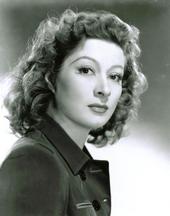..
The epitome of a star, this dignified redheaded actress knew how to add spice to a movie when it needed it most. She was perhaps the one of most popular of MGM’s leading ladies in the 1940’s and always presented her characters with elegance and poise. Her success garnered her five consecutive Oscar nominations, a feat only matched by Bette Davis.
Eileen Evelyn Garson was born a century ago, September 29, 1908. Her father passed away shortly after her birth, but she and her mother struggled to survive through the poverty that seemed to haunt the Garson household. Garson’s childhood was fairly normal; she had no thoughts of acting but excelled at her studies. She received a scholarship and was schooled at the University of London. Garson did well, earning a B.A. honors in French and 18th century literature. She had strong aspirations of becoming a teacher, but instead took a job with an advertising agency for some time. Acting was not something that held her interests high, but she decided to try to her luck acting in local theatrical productions. Changing her first name to Greer, a derivative of her mother’s maiden name, MacGregor, she made her debut in 1932 in Street Scene and earned the respect of critics. Garson gained herself a good reputation as an exceptionally gifted actress, and rightfully so, under the tutelage of (Sir) Laurence Olivier. The two starred together on the London stage in 1935 and both received great accolades. Garson attracted the interest of Louis B. Mayer while he was making one of his famed trips across the ocean searching for new talent. He convinced her to come to Hollywood on a one-year contract with MGM, earning $500 a week, though Garson didn’t work that first year.
Garson returned to London in 1939 where MGM’s Sam Wood was set to film Goodbye Mr. Chips with Robert Donat. She appeared as Mr. Chipping’s (Donat) love interest, adding a touch of romance and strength in Chipping’s lonely, shy life. Her short but endearing performance earned her an Oscar nomination and it seemed MGM had indeed found a new star. MGM was excited about her onscreen possibilities and soon cast her as Elizabeth Bennett opposite Laurence Olivier’s Fitzwilliam Darcy in 1940’s esteemed adaptation of Jane Austen’s Pride and Prejudice. Maybe it was the famed open-mouthed kiss between Garson and Olivier that stirred the most attention, yet MGM remained confident of Garson’s rising success. She became one of Hollywood's biggest stars of the 1940s earning five Best Actress nominations in a row for such prestige films as Blossoms in the Dust (1941), Madame Curie (1943) and Mrs. Parkington (1944) (all opposite Walter Pidgeon) as well as The Valley of Decision (1945) with Gregory Peck.
In her most famous role, Garson won her first Oscar for her portrayal of the determined British matriarch in William Wyler’s patriotic World War II drama. Mrs. Miniver was extremely popular on both sides of the Atlantic, becoming one of the biggest successes in the United States during the 1940s. Later that same year, Garson starred in another hugely successful film – Mervyn LeRoy’s Random Harvest, an entertaining romantic story also starring Ronald Coleman. Madame Curie (1943) was a strong and engaging story, with Garson shining in the starring role. Her career was fast on the rise, and she was convincingly leaving her mark on Hollywood. So it’s ironic that Garson’s Best Actress Oscar acceptance speech in 1943 for Mrs. Miniver is now famous as being the longest in Academy history. Reports listed it as being over an hour long, but historians have confirmed that it was only about five and a half minutes long.
In 1958, she took over the title role from Rosalind Russell in Broadway’s "Auntie Mame" and made a triumphant return to the big screen in her last Oscar nominated performance as Eleanor Roosevelt in 1960’s Sunrise at Campobello. Nearly a decade after she left MGM, she starred in the 1965 Debbie Reynolds musical The Singing Nun before appearing opposite Fred MacMurray in her last film, Disney’s musical comedy The Happiest Millionaire (1967). She turned her attentions to causes related to the performing arts, supportive of theatre division of the Meadows School of Arts at Southern Methodist University where in 1990 she gave $10 million toward the construction of the school's Greer Garson Theatre. The British government named Garson a Dame in 1972 and an honorary Commander of the British Empire in 1993.
Garson had a clear philosophy… "All I know about getting something that you want is that there are three essential things: wanting, trying and getting the opportunity, the breaks. None works alone without the others. Wanting is basic. Trying is up to you. And the breaks - I do know this, they always happen". Just as actress Eve Plumb (who co-starred with Garson in TV’s Little Women, once recalled, "I remember her as gracious and beautiful. She had stature, but it didn't make her inaccessible. She wasn't somebody you'd poke and tell a dirty joke to, but she gave off a real feeling of warmth".
